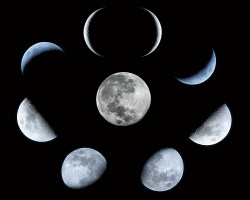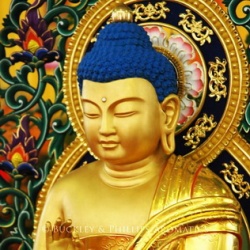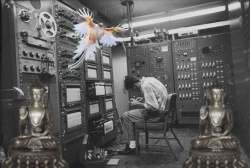New Moon
In astronomy, new moon is the first phase of the Moon, when it lies closest to the Sun in the sky as seen from the Earth. More precisely, it is the instant when the Moon and the Sun have the same ecliptical longitude. The Moon is not normally visible at this time except when it is seen in silhouette during a solar eclipse. See the article on phases of the Moon for further details. New Moon - Protection of life is especially recommended. The effects of positive or negative actions are multiplied 100 times.
The original meaning of the phrase new moon was the first visible crescent of the Moon, after conjunction with the Sun. This takes place over the western horizon in a brief period between sunset and moonset, and therefore the precise time and even the date of the appearance of the new moon by this definition will be influenced by the geographical location of the observer. The astronomical new moon, sometimes known as the dark moon to avoid confusion, occurs by definition at the moment of conjunction in ecliptical longitude with the Sun, when the Moon is invisible from the Earth. This moment is unique and does not depend on location, and in certain circumstances it coincides with a solar eclipse.
The new moon in its original meaning of first crescent marks the beginning of the month in lunar calendars such as the Muslim calendar, and in lunisolar calendars such as the Hebrew calendar, Hindu calendars, and Buddhist calendar. But in the Chinese calendar, the beginning of the month is marked by the dark moon.
Although the new moon is typically depicted as a black circle, its actual phase is a very thin crescent, because the moon does not pass directly in front of the sun (except during an eclipse). On July 8, 2013, French astrophotographer Thierry Legault successfully photographed the new moon, although the crescent itself was not visible to the unaided eye.
The new moon is quite significant in Hindu calendar. People generally wait for new moon to start new works. Waxing period of moon is considered good for all good works. Fifteen Moon dates each for waxing and waning period are there. Fifteen dates are classified in five categories, namely Nanda, Bhadra, Jaya, Rikta and Purna and three rotations of these five categories are there. The category rotation starts from first date of moon ending at fifth date and then starting at sixth date and so on. Nanda dates come on First, Sixth and Eleventh moon date, same can be known about others.
Nanda dates are good for auspicious works. Bhadra dates can be good for works related with community, social, family, friends. Jaya dates are good where we need to deal with some conflict. Rikta dates are not considered much good and do good for works related with cruelty. Purna dates are good for every work. The first day of the Lunar Hindu calender starts the day after the no moon day(Amavasya). Hindu astrology considers amavasya as powerful, either good or bad. The Hundi epic, Mahabharatha states that the Kurukshetra war started on the Amavasya day that too on a Tudesay (Mangalvaar, day of the week named after Mars).
The Islamic calendar has retained an observational definition of the new moon, marking the new month when the first crescent moon is actually seen, and making it impossible to be certain in advance of when a specific month will begin (in particular, the exact date on which Ramadan will begin is not known in advance). In Saudi Arabia, if the weather is cloudy when the new moon is expected, observers are sent up in airplanes. In Pakistan, there is a "Central Ruet-e-Hilal Committee" whose head is Mufti Muneeb-ur-Rehman, which takes help from 150 observatories of the Pakistan Meteorological Department all over the country and announces the decision of sighting of new moon. But for the last 25 years, status of the "Central Ruet-e-Hilal Committee" has been very much controversial, as Mufti Muneeb-ur-Rehman always use to refuse the "Witnesses" (Shahadats) from other sects. In Iran a special committee receives observations of every new moon to determine the beginning of each month. This committee uses one hundred groups of observers.
An attempt to unify Muslims on a scientifically calculated worldwide calendar was adopted by both the Fiqh Council of North America and the European Council for Fatwa and Research in 2007. The new calculation requires that conjunction occur before sunset in Mecca, Saudi Arabia and that moon set on the following day must take place after sunset. These can be precisely calculated and therefore a unified calendar is imminent if it becomes adopted worldwide.
The new moon is the beginning of the month in the Chinese calendar. Some Buddhist Chinese keep a vegetarian diet on the new moon and full moon each month.
The new moon signifies the start of every Jewish month, and is considered an important date and minor holiday in the Hebrew calendar. The modern form of the calendar is a rule-based lunisolar calendar, akin to the Chinese calendar, measuring months defined in lunar cycles as well as years measured in solar cycles, and distinct from the purely lunar Islamic calendar and the almost entirely solar Gregorian calendar. According to Jewish tradition, the Jewish calendar is calculated based on mathematical rules handed down from God to Moses at the moment the command was given to make sure that Passover always falls in the springtime. More likely, this fixed lunisolar calendar was introduced by Hillel II. This calculation makes use of a mean lunation length used by Ptolemy and handed down from Babylonians (see Lunar_theory#Babylon), which is still very accurate: ca. 29.530594 days vs. a present value (see below) of 29.530589 days. This difference of only 0.0000005, or five millionths of a day, adds up to about only 4 hours since Babylonian times.
The messianic Pentecostal group, the New Israelites of Peru, keeps the new moon as a Sabbath of rest. As an evangelical church, it follows the Bible's teachings that God sanctified the seventh-day Sabbath, and the new moons in addition to it. See Ezekiel 46:1, 3. No work may be done from dusk until dusk, and the services run for 11 hours, although a large number spend 24 hours within the gates of the temples, sleeping and singing praises throughout the night.
The new moon is also important in astrology, as is the full moon.
The new moon is when the moon is close to the sun in the sky. Because of this when it is new it completely dissapears to the night observer and then begins to grow again. By convention a new moon signifies the start of a new cycle. (Of course its still there but you just cannot see it at first)
The full moon is when the moon is in the opposite sector of the sky to the sun, and is and also appears, as far away from the sun as it can get.
In astrology the new moon = moon conjunct sun, and full moon = moon oppose sun. This means the new moon will be in harmony with the Sun while the full moon will show the opposite of the energies which the Sun has been projecting. A new moon is seen as a reawakening and new start as the energy the moon brings works with the energy of the Sun to solve things and harmonise. A full moons energy points out the direct opposite of what the energy that the Sun is projecting. This is why tensions can be high and fears roused at the full moon.
Quarter moon is when the new moon is still growing and appears a half moon in size because it is half way to the full moon. This moon is 90 degrees in the sky from the Sun and waxing (getting bigger). It is called quarter moon not because it is a quarter of the way through the moon cylcle.
A Three Quarter moon is again a half moon but its waning (getting smaller). The full moon has passed and it is heading back towards the new moon. Astrologers often call this the 'Last Quarterly Moon' instead of three quarter moon to make things more confusing!
Both types of quarterly moons also tend to generate tension as a 90 degree angle is not a harmonising aspect. It is known for creating tension but a lot can also be acheived with this aspect. Same with a full moon. They are not allways bad. Their intensity can be good if you need the energy to finish off a project or the polarisation between the Moon and Sun can also lead to answers just as the New Moon can but from means of offering a new perspective rather than harmonising.
The new moon is quite significant in Hindu calendar. People generally wait for new moon to start new works. Waxing period of moon is considered good for all good works. Fifteen Moon dates each for waxing and waning period are there. Fifteen dates are classified in five categories, namely Nanda, Bhadra, Jaya, Rikta and Purna and three rotations of these five categories are there. The category rotation starts from first date of moon ending at fifth date and then starting at sixth date and so on. Nanda dates come on First, Sixth and Eleventh moon date, same can be known about others. Nanda dates are good for auspicious works.
Bhadra dates can be good for works related with community, social, family, friends. Jaya dates are good where we need to deal with some conflict. Rikta dates are not considered much good and do good for works related with cruelty. Purna dates are good for every work. The first day of the Lunar Hindu calendar starts the day after the no moon day (Amavasya). Hindu astrology considers amavasya as powerful, either good or bad. The Hindu epic, Mahabharatha states that the Kurukshetra war started on the Amavasya day that too on a Tudesay (Mangalvaar, day of the week named after Mars).
The new moon is the beginning of the month in the Chinese calendar. Some Buddhist Chinese keep a vegetarian diet on the new moon and full moon each month.
The new moon signifies the start of every Jewish month, and is considered an important date and minor holiday in the Hebrew calendar. The modern form of the calendar is a rule-based lunisolar calendar, akin to the Chinese calendar, measuring months defined in lunar cycles as well as years measured in solar cycles, and distinct from the purely lunar Islamic calendar and the almost entirely solar Gregorian calendar. According to Jewish tradition, the Jewish calendar is calculated based on mathematical rules handed down from God to Moses at the moment the command was given to make sure that Passover always falls in the springtime.
More likely, this fixed lunisolar calendar was introduced by Hillel II. This calculation makes use of a mean lunation length used by Ptolemy and handed down from Babylonians (see Lunar theory#Babylon), which is still very accurate: ca. 29.530594 days vs. a present value (see below) of 29.530589 days. This difference of only 0.0000005, or five millionths of a day, adds up to about only 4 hours since Babylonian times.
The messianic Pentecostal group, the New Israelites of Peru, keeps the new moon as a Sabbath of rest. As an evangelical church, it follows the Bible's teachings that God sanctified the seventh-day Sabbath, and the new moons in addition to it. See Ezekiel 46:1, 3. No work may be done from dusk until dusk, and the services run for 11 hours, although a large number spend 24 hours within the gates of the temples, sleeping and singing praises throughout the night.
The new moon is also important in astrology, as is the full moon.
The Tibetan Master indicates that the “inbreathing” and “outbreathing” of the entity, who is the Earth, potently affects the physical plane. He states that there is a connection with this and the moon.* This connection with the moon is related to the cycles of the moon.
The time of the new moon is a time to breathe in deeply and move into a calm state of mind. In this state, you can watch your emotions come and go and not be affected by them. In this calmness, you begin to see your life more clearly; you begin to see what is possible.
Now you can tune into your Soul or Higher Self. Stay calm, and let your Higher Self give you a vision of your true purpose.
The new moon is the symbol of beginnings. This is a good time to contemplate upon your true motive. Why are you here on Earth? What did you come here to accomplish? What is your spiritual intention?
These questions tune you into the core of your being. The core of your being is in touch with the great being of the Earth. This aligns you with the dynamic vibration of purpose. One definition of purpose is a goal that you set before yourself that you desire to attain. When that purpose has an element of goodwill, it is harmonizing with the great being of the Earth.
The moon represents the form. This is a time to think about what form you want to create. If you are already involved in your purpose, you can consider whether there is anything you need to do to adjust your plan to create a better form.
You are not alone. When you tune in to your Soul’s vision, you invite the Guides of our planet, the Hierarchy of Light, into your life. They are as the Heads of a giant organization. Your Soul’s vision and purpose is a necessary part of the Organization’s plan for humanity.
When you are attuned to your Soul’s vision, you feel magnetic. You can breathe in and out and relax. There is tension, but it is spiritual tension. In spiritual tension, you keep yourself synchronized with your Soul’s vision through an act of will.
You feel magnetized because you are in harmony with the Earth. When you are in harmony with the earth, you give positivity to others. You anchor light and love and spiritual power on Earth.
When the Moon is new, the Sun and Moon are aligned in the same sign, and a powerful energy portal is opened. New Moons are a great time to set intentions for things you'd like to create, develop, cultivate, make manifest. There are many ways to initiate this communion with the Universe from lighting a candle to elaborate rituals. What matters is that you're committing yourself to your vision, and open to receiving guidance, healing, support from Spirit.
Why Follow the Moon?:
When you tune into the Moon's phases, it's reassuring to know that there are many chances during the year to tap into lunar energy. Like the tides, the Moon ebbs and flows, a rhythm that women understand intimately. New Moons are a blank page on which to speak your dreams out loud, and Full Moons are for taking action and celebrating the fruit of your efforts.
In the chaotic and temporal world, looking to something larger that is also part of yourself can fill you with awe and make you feel connected. For whatever path you're on, opening to working with planetary energies links you to the power of the divine.
Preparing for the New Moon:
It's a good idea to spend some time reflecting in the days leading up to the new Moon. Knowing exactly what you want to draw into your life is not always easy. Part of preparing for the new Moon is making sure you are clear about your intentions. Sometimes it's a quality you'd like to cultivate like forgiveness, courage -- other times it's a more specific request like a promotion at work or new place to live.
What is a new Moon Ritual?:
This depends on your personal tastes, the pace of your life and the time you have to devote to it. Some simply light a candle, while others gather objects and pictures for their altar. Lately, I've been writing my intentions on a 7-day candle and leaving it in a prominent (and safe) place. With a candle, you can return to it and relight it while meditating on your intentions.
Ritual helps focus your entire being on the quest at hand. In the days leading up to the new Moon, you might gather pictures and totems that symbolize your goal. Creating a collage gives you a visual reminder of your dreams.
What does it mean in each different sign?:
Every new Moon is different, and this gives you the chance to claim the energies of each different sign. Even if you don't have planets in the sign for a given month, it falls somewhere in your birth chart. We each have elements of the entire Zodiac in our make-up, with some more emphasized than others. Find out where the new Moon falls in your chart for clues as to what to "call in" that month.
How is it different from the Full Moon:
The new Moon has a more inward feel, has a void or empty quality, and therefore can be frightening to those not comfortable with uncertainty. Can you learn to trust the dark? It's the moment when the old passes away and the new is not yet here. That's why it's a powerful time for sending out your prayer, wishes, desires to the Universe.
Each phase of the Moon resonates with magical significance and astrological meaning.
These meanings spill out into world-wide folklore, sinister superstitions, and even gardening advice. Werewolves, in particular, are creatures of the Moon – transforming themselves by the light of the full Moon into deadly hunters which can only be killed by a silver bullet. Hairy, scary creatures aside….the Moon’s phases are used in witchcraft and magic to determine when to cast a certain kind of spell. New Moons are for beginnings, for example, while the waning Moon is believed to be a good time for banishing things, or clearing negative influences. In predictive astrology these phases reveal different themes in your life, and offer a guide to planning activities, projects, and even study. If you want to try tuning in to these phases you’ll need to observe the Moon every evening, cloud permitting, and check exact details of its phase in an almanac or moon calender.
The New or Crescent Moon - Beginnings
It’s time to begin projects, new regimes, fresh starts. Some gardeners maintain that this is the best time to plant seeds – you can easily imagine that this is a symbol for many things.
The First Quarter Moon - Action
The Moon reaches her first quarter seven days after the New Moon. Take your projects out there and do something practical about those decisions or wishes you made when the Moon was new.
The Gibbous Moon – Movement
The Moon is now waxing larger as it moves from New towards Full. The next seven days have a forward momentum. If you began something new, like a diet, at the New Moon, you should be seeing some results by now. Not the final results you imagined, but moving towards them.
The Full Moon – Harvest
The lunar energies peak now, fourteen days into the cycle. It is harvest time, possibly for projects begun at a New Moon months beforehand. Results in just two weeks are hard to find in most endeavours……although we can always dream. Emotions may peak one way or another too.
The Disseminating Moon – Thinking
The Moon begins to wane, and energies and thoughts turn inwards. This is a good time to think about your projects or the direction you are following. Use what you have learned and bide your time.
The Third Quarter Moon – Shuffling the deck
If you need to fine-tune things, now’s the time. It’s about seven days since the Full Moon. Work with what you have, and make it better. It’s not a good time to go after anything new, but a great time to polish up your skills and make things work out. Anything you don’t need, or which isn’t working can be recycled or thrown out now. Needless to say, this is a good time to clear out cupboards, weed your garden, or get a sassy new haircut.
The Balsamic Moon - Release
The waning Moon has reached its last phase. It is a time of release. If you want to let go of a relationship, job, or anxiety this is the perfect time to focus on this desire. You may feel peaceful, or empty. The final days just before the New Moon are also called the dark of the Moon, because it sheds so little light. Symbolically, this suggests the inner world is more important than the outer world at this point in the cycle.












